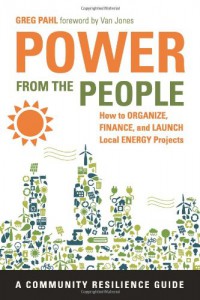“We must take rapid, effective, innovative action to change the ways we generate and use energy; renewable energy is ubiquitous, offering a new model of energy generation that is local, democratic, and free from the abuses of a centralized monopoly.”
 This week I focus on community energy. The call to action above is from the Energy Democracy, Renewable Communities Alliance and leads off the last chapter of Power From The People,” by Greg Pahl. The book discusses how to organize, finance and launch local energy projects. While the book is now a few years old, the information in which it contains is still valuable.
This week I focus on community energy. The call to action above is from the Energy Democracy, Renewable Communities Alliance and leads off the last chapter of Power From The People,” by Greg Pahl. The book discusses how to organize, finance and launch local energy projects. While the book is now a few years old, the information in which it contains is still valuable.
Local energy, writes Pahl, is the result of rethinking energy to look at ways of becoming more energy-resilient that don’t necessarily rely on centralized corporate-dominated utilities. “Simply stated, local energy projects rely on locally available renewable energy resources that service local needs.” This can be solar, wind, biomass, ag waste, and more and in some instances can become regional projects such as a hydropower project.
The book walks the reader through the current energy situation from a climate and economic perspective and discusses why and how to “rethink” energy. Pahl then moves to how a consumer can make his/her home energy resilience and then how a community can become energy resilient. Throughout the dialogue, Pahl provides examples of successful projects – even some that took years and a lot of creative thinking to come into fruition. He also offers four core principles of community energy.
- Community Ownership, Community Benefit: Ensuring that projects meet broader needs of the community including the health of the local economy and environment.
- Renewable, Local, and Distributed: Renewables by definition won’t run out, so they are ideal for building local energy security.
- Adaptive Resilience: A community is not going anywhere, so the ability to adapt to changing conditions is essential.
- Conservation First: We must reduce the overall amount of energy we use.
One of the most important messages in his book is that there is place for all renewable energy project sizes and it will take all of these projects to reduce our dependence on fossil-fuel based energy sources, and reduce the negative impact on economies and the environment. Another word of advice that really struck out: “But as with any renewable energy system, scale and context matter: A technology that might be destructive at utility scale can be quite sustainable and beneficial at small, local scale if organized and operated properly.”
Pahl ends the book with a call to action: get your own home in order by becoming as energy resilient as you can and then join with your neighbors to relocalize the economy while increasing your community’s energy resilience. “So much to do. So little time. Better get to work.” Pahl’s parting words and his book delivers on how to do just this.

